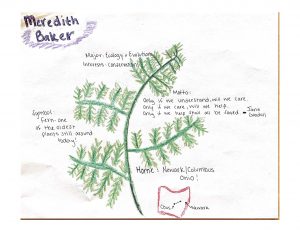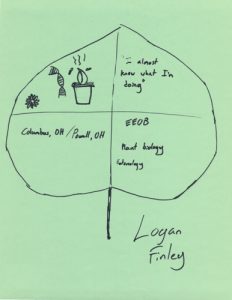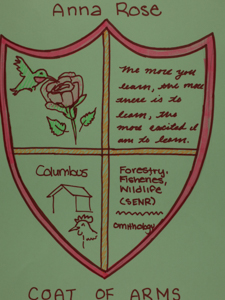QUIZ 1 STUDY TOPICS
1) Trees. ID features (leaf arrangement, complexity and margin), genus (i.e., Fraxinus instead of ash, if asked), common name (i.e., ash), and two, two, two facts per tree (according to the tree research assignment to be handed in with your quiz)
2) Adaptations for life on land and which plants have which adaptations
3) Common and scientific names of the major branches (phyla) on the plant kingdom tree of life (phylogeny)
4) Life cycle processes, cells, and organisms and structures (i.e., spore, gamete, meiosis, archegonium) defined and/or identified/labelled on a life cycle diagram
5) Flower parts
6) Ability to describe and state the location of the life cycle stages (sporophyte and gametophyte) for the 3 major plant groups we learned (moss, fern, angiosperm)
7) Double fertilization explained
8) “Fruit” and “seed” defined and parts of a fruit and a seed

EEOB 2210 TERM PROJECT
BOTANICAL SURVEY
Effective stewardship of natural areas depends upon an accurate accounting of the biotic resources, particularly the vegetation, present on a site. The development of a site-specific plant species list, along with a written description of the plant communities that are there (including relevant information about the human and natural ecology of the plants) is often desired by natural resource agencies, landowners, and environmental organizations. This substantial (100 point) assignment is to perform and document a botanical survey like the ones performed by professional field botanists engaged in environmental assessment. The specifications for this project are here (link to .pdf below)
BOTANICAL SURVEY INSTRUCTIONS
SAMPLE BOTANICAL SURVEY
HERE ARE RECOMMENDED SITES
(touch-screen navigate using 2 fingers)
HERE ARE RECOMMENDED SITES
(touch-screen navigate using 2 fingers)
WEEK 2: DENDROLOGY (trees) WEB PAGE ASSIGNMENT
Due Sunday September 1 (credit 20 pts.)
Tree Assignment Content Guidelines: For context and inspiration, read this article in a recent New York Times (LINK). Cite and expand upon the points that Popkin makes in your tree page.
This week we will apply and extend the tree identification skills that we learned last week. Go out into the world and discover 8 wild (not cultivated) broad-leaved (not conifer) trees. Identify them to species using your Peterson’s Field Guide to Trees and Shrubs. At least half of them must belong to different genera than the 8 we learned in class. Photograph your 8 trees close enough up (close up enough?) (up close enough??) (up with enough closeness???) to see the features that allow it to be recognized for what it is. Provide two photos of each tree –one showing the overall shape and form, and one showing leaf details. To acheive further fame and glory, include some pictures of the bark or the fruit, if present.
Provide the following information about each tree:
-
- common and scientific names, the latter written properly in terms of capitalization and italics.
- a written description of the pertinent identification features: leaf arrangement, complexity, and other traits that, taken together, distinguish that particular species.
- where you saw the tree, both the site locations and the habitat (the type of environment, i.e., swamp forest), and any impressions you had of thr tree and the setting. What was it like to meet this tree?
- for each tree, provide TWO interesting statements about the tree’s human or natural ecology that you hadn’t known before, from the following sources.
—ONE of the the facts needs to come from your field guide, and be cited (copy/paste) as such (Petrides, George A. 1972, Trees and Shrubs of Northeast and North Central US and Southeast and South Central Canada (Peterson Field Guide). Houghton Miflin, 428 pp.).
—ANOTHER of the facts should be from a reliable and interesting internet source and must be cited, both by site name and hyperlink. Herer are four recommendations, properly cited:
1. Lady Bird Johnson Wildflower Center Native Plant Information Network (ACSA2)
2. Native American Ethnobotany: A Database of Foods, Drugs, Dyes and Fibers of Native American Peoples, Derived from Plants.
3. Minnesota Wildflowers
4. Illinois Wildflowers - Do please have fun with this; be creative, and be sure to compare your experiences with the ones recounted by Gabriel Popkin in the “Tree Blindness” article you read.
Some exemplary web sites from past classes are the following. Check out their TREES pages for inspiration and format guidance.
From the Archives: Examples of Really Good Student Web Sites
Let’s Set Up Web Sites
(pages not posts; full width, no sidebars)
Hi ho Botanists! In class on Wednesday you all were assigned a name that you will use as the name (web address) of your new u.osu.edu web site. For example, Brett’s site is https://u.osu.edu/asarum5/. Follow the instructions in the video below, being sure to adhere to the following principles:
Steps for creating websites:
- Change theme to Orton (top left of page)
- Go to dashboard then to posts and remove default post (we won’t be using posts)
- While on dashboard, add new page called Home and immediately change template to Full-Width no sidebar (should be on right-hand side of page)
- Add a picture and short introduction then hit publish
- Next, delete the sample page
- Next (still on dashboard), make the Home Page static by going to Settings -> Reading -> Make Static Page and select your Home Page.
- Click Visit Site. One loaded, hit the Customize Tab (Top left of page) and add a botanically inclined header image (Large or Full Size!)
- Make new Pages for each field trip and/or assignments with large or full size pictures and captions for information.
- Email with any questions/issues (lambert.648)
Have fun with this!
LINKS TO WEB SITES

LINKS TO WEB SITES





































